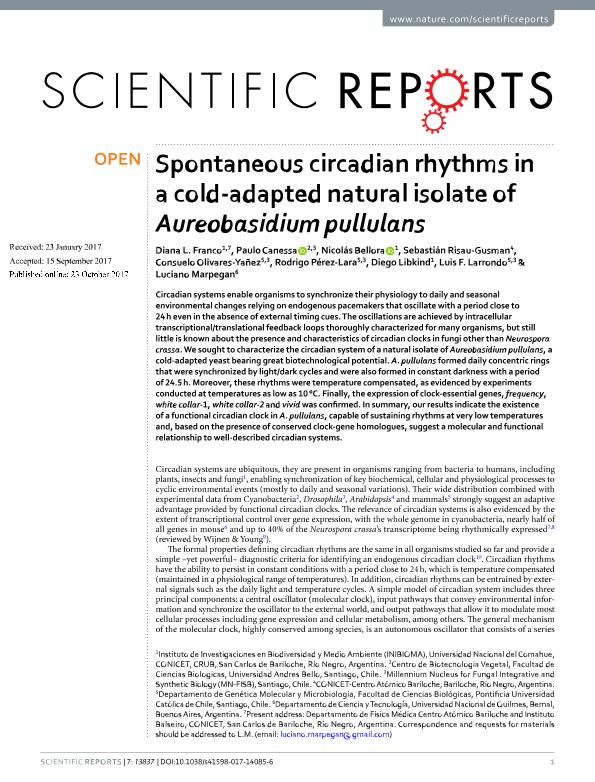Artículo
Spontaneous circadian rhythms in a cold-adapted natural isolate of Aureobasidium pullulans
Franco, Diana Lorena ; Canessa, Paulo; Bellora, Nicolás
; Canessa, Paulo; Bellora, Nicolás ; Risau Gusman, Sebastian Luis
; Risau Gusman, Sebastian Luis ; Olivares Yañez, Consuelo; Pérez Lara, Rodrigo; Libkind Frati, Diego
; Olivares Yañez, Consuelo; Pérez Lara, Rodrigo; Libkind Frati, Diego ; Larrondo, Luis F.; Marpegan, Luciano
; Larrondo, Luis F.; Marpegan, Luciano
 ; Canessa, Paulo; Bellora, Nicolás
; Canessa, Paulo; Bellora, Nicolás ; Risau Gusman, Sebastian Luis
; Risau Gusman, Sebastian Luis ; Olivares Yañez, Consuelo; Pérez Lara, Rodrigo; Libkind Frati, Diego
; Olivares Yañez, Consuelo; Pérez Lara, Rodrigo; Libkind Frati, Diego ; Larrondo, Luis F.; Marpegan, Luciano
; Larrondo, Luis F.; Marpegan, Luciano
Fecha de publicación:
10/2017
Editorial:
Nature Publishing Group
Revista:
Scientific Reports
e-ISSN:
2045-2322
Idioma:
Inglés
Tipo de recurso:
Artículo publicado
Clasificación temática:
Resumen
Circadian systems enable organisms to synchronize their physiology to daily and seasonal environmental changes relying on endogenous pacemakers that oscillate with a period close to 24 h even in the absence of external timing cues. The oscillations are achieved by intracellular transcriptional/translational feedback loops thoroughly characterized for many organisms, but still little is known about the presence and characteristics of circadian clocks in fungi other than Neurospora crassa. We sought to characterize the circadian system of a natural isolate of Aureobasidium pullulans, a cold-adapted yeast bearing great biotechnological potential. A. pullulans formed daily concentric rings that were synchronized by light/dark cycles and were also formed in constant darkness with a period of 24.5 h. Moreover, these rhythms were temperature compensated, as evidenced by experiments conducted at temperatures as low as 10 °C. Finally, the expression of clock-essential genes, frequency, white collar-1, white collar-2 and vivid was confirmed. In summary, our results indicate the existence of a functional circadian clock in A. pullulans, capable of sustaining rhythms at very low temperatures and, based on the presence of conserved clock-gene homologues, suggest a molecular and functional relationship to well-described circadian systems.
Palabras clave:
Circadian Rhythms
,
Fungi
,
Bioinformatics
,
Oscillatory Systems
Archivos asociados
Licencia
Identificadores
Colecciones
Articulos(CCT - PATAGONIA NORTE)
Articulos de CTRO.CIENTIFICO TECNOL.CONICET - PATAGONIA NORTE
Articulos de CTRO.CIENTIFICO TECNOL.CONICET - PATAGONIA NORTE
Citación
Franco, Diana Lorena; Canessa, Paulo; Bellora, Nicolás; Risau Gusman, Sebastian Luis; Olivares Yañez, Consuelo; et al.; Spontaneous circadian rhythms in a cold-adapted natural isolate of Aureobasidium pullulans; Nature Publishing Group; Scientific Reports; 7; 1; 10-2017; 1-12; 13837
Compartir
Altmétricas



